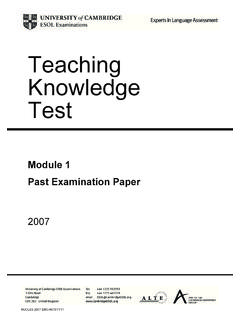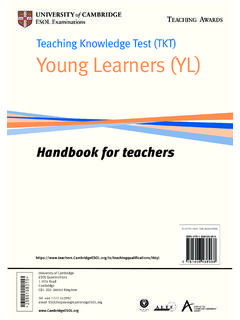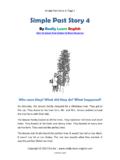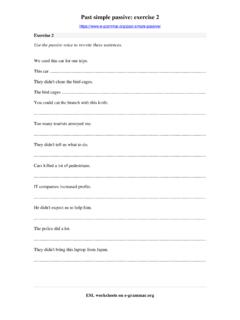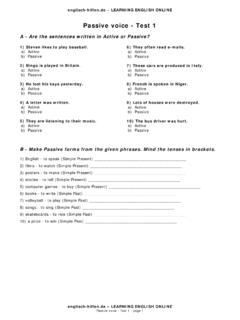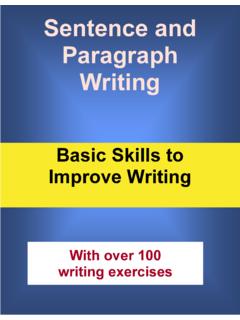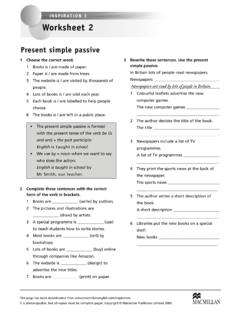Transcription of TKT Past Paper 2007 Module 2 - tkttw.com
1 Teaching Knowledge Test Module 2. past Examination Paper 2007 . UCLES 2007 EMC/4876/7Y11. Candidate Centre Number Number Candidate Name UNIVERSITY OF CAMBRIDGE ESOL EXAMINATIONS. English for Speakers of Other Languages TEACHING KNOWLEDGE TEST 002. Module 2 Version 07. Lesson planning and use of resources for language teaching 1 hour 20 minutes Additional materials: Answer sheets Soft clean eraser Soft pencil (type B or HB is recommended). TIME 1 hour 20 minutes INSTRUCTIONS TO CANDIDATES. Write your name, Centre number and candidate number in the spaces at the top of this page. Write these details on your answer sheet if they are not already printed. Do not open this booklet until you are told to do so. There are eighty questions in this Paper . Answer all questions. Mark your answers on the separate answer sheet. Use a pencil. You may write on the question Paper , but you must mark your answers in pencil on the answer sheet. You will have no extra time for this, so you must finish in one hour and twenty minutes.
2 At the end of the test, hand in both the question Paper and the answer sheet. INFORMATION FOR CANDIDATES. Each question in this Paper carries one mark. This question Paper consists of 15 printed pages and 1 blank page. PV5. UCLES 2006 [Turn over 2. For questions 1-6, match the textbook rubrics with the lesson aims listed A, B or C. Mark the correct letter (A, B or C) on your answer sheet. Lesson aims A developing pronunciation skills B developing reading skills C developing vocabulary Textbook rubrics 1 Choose the best summary of each paragraph. 2 Listen and group the words according to whether they have two, three or four syllables. Practise saying them in pairs. 3 Complete this chart with the correct prefixes or suffixes. 4 Indicate on the map the way that Kate went, according to the information given. 5 Read and listen to the dialogue and underline the weak forms. 6 Circle the noun in each set which does not collocate with have. 3. For questions 7-15, match the information from a lesson plan with the lesson plan headings listed A-E.]
3 Mark the correct letter (A-E) on your answer sheet. You need to use some options more than once. Lesson plan headings A Lesson aim(s). B Anticipated problem(s). C Procedure and interaction D Aids and resources E Personal aim(s) of teacher Information from a lesson plan 7 Stronger students may dominate in pairwork. 8 Remember to use gestures to encourage self-correction whenever possible. 9 Develop dictionary skills. 10 Students use dictionaries individually to check the meaning of vocabulary. 11 Students have difficulty with phonemic transcriptions. 12 Dictionary on CD-Rom. 13 Raise students' awareness of learning strategies. 14 Students complete the task in groups. 15 Students, in pairs, match phonemic transcriptions to the correct spellings of vocabulary. [Turn over 4. For questions 16-22, look at the stages of an integrated skills lesson, each of which has three possible main aims listed A, B or C. Two of the aims for each stage are appropriate.]
4 One of the aims is NOT appropriate. Mark the aim (A, B or C) which is NOT appropriate on your answer sheet. Stages Main aims 16 Lead-in The teacher shows the students some photographs of a famous singer and elicits what they know about him. To help students A have a purpose for reading. The teacher asks the students what they can guess about the singer from the photos B learn new grammar items. and title of an article. C develop prediction skills. The students decide whether written statements about the singer could be true or false. 17 Reading 1. To encourage students to The students quickly read an article about the singer to find out whether their answers A infer the writer's attitude. to the true/false questions were correct. B scan. They compare their answers in pairs. C only read necessary information. 18 Reading 2. The students underline the topic sentence of each paragraph. To give students practice in The students are given a jumbled list of A identifying the main points of a text.
5 Paragraph headings. B reading extensively. The students match the headings to the C understanding how texts develop. topic sentences in the article. 5. 19 Vocabulary development For students to The students read definitions of some phrases from the text. A learn new expressions. The students find phrases in the text which B practise deducing meaning from match the definitions. context. The students compare their answers in C develop oral fluency skills. pairs. 20 Language focus To give students an opportunity to The teacher elicits typical language used in a biography, such as past forms and A develop writing skills. adverbs of time. B revise language. The students underline examples of past forms and adverbs of time in the text. C prepare for the writing stage. 21 Writing The students use the library or a computer To encourage students to to find out information about a famous person of their choice. A focus on the layout of a text. B practise the language they have The students write a text about this learned.
6 Person's life, including past forms and adverbs of time. C develop independent learning skills. The students look at each other's work and correct it. 22 Class mingle The students put their texts up on the classroom wall. They do not say who the For students to practise famous person is. A reading skills. The students look at everyone's texts to B oral communication skills. identify who the people are. C editing skills. The students mingle and ask each other yes/no' questions about the people in the texts they cannot identify. (Example: Is he still alive?). [Turn over 6. For questions 23-29, put the stages of a writing skills lesson plan in order. Mark the correct letter (B-H) on your answer sheet. The first stage (A) is done for you. You do not need to use option A again. A The teacher gives the students a short newspaper article about a swimming pool in their town that may close down and tells them they 0 .. are going to write a letter to the newspaper to ask for the pool to stay open.]
7 23 .. B Students choose the six best reasons and the teacher writes these on the board. 24 .. C Groups check each other's letters for grammar and spelling errors and correct these. 25 .. D The teacher asks students in groups to brainstorm reasons for keeping the swimming pool open. 26 .. E The teacher asks the students in their groups to write a draft letter using three of the reasons from the written list. 27 .. F The teacher collects all the letters to send to the editor of the newspaper. 28 .. G Groups tell the whole class their list of reasons. 29 .. H Groups write an improved draft of their letter. 7. For questions 30-35, match the example assessment items with their grammatical focus listed A-G. Mark the correct letter (A-G) on your answer sheet. There is one extra option which you do not need to use. Grammatical focus A superlatives B past simple C present continuous D gerunds and infinitives E present simple passive F second conditional G relative pronouns Example assessment items 30 Complete the sentences with the correct word(s).
8 I .. there for six years before moving to Budapest. 31 Complete the descriptions with who or which. This is a kind of cheese .. is made from goat's milk not cow's milk. 32 Rewrite the sentences using the correct form of the verbs in brackets. Where (you/fly) if (you/be) a bird? 33 Complete the sentences with the correct form of the verbs in brackets. Coffee (grow) in Brazil. It (export) to many countries in the world. 34 Complete the sentences with .. +ing or to + .. I decided (send) a letter to my friend. 35 Complete the sentences with an appropriate adjective. Shanghai is the .. city in the world. [Turn over 8. For questions 36-40, look at the syllabus areas which a teacher wants to test and three possible testing methods. Two of the methods are suitable for testing the syllabus areas. One of the testing methods is NOT. suitable. Mark the method (A, B or C) which is NOT suitable on your answer sheet. 36 spelling of everyday words connected with food and cooking A The teacher dictates 25 words from a recipe.]
9 B Students, in pairs, discuss differences between two pictures of kitchens. C Students find mistakes in a restaurant's menu. 37 knowing the correct word stress for the names of different countries A Students underline the appropriate syllable(s) in country names. B Students look at three different patterns and categorise each country name under the correct pattern. C Students write country names in the right position on a map of the world. 38 correctly using regular and irregular past simple forms A Students tell their partner a story about what they did last summer. B Students write an essay about their hopes and plans. C Students do a gap-fill task about a bank robbery in which all the verbs are missing. 39 taking part in simple shopping conversations A Students read a text about new supermarkets in Britain. B Students do a role-play about buying new shoes. C Students record themselves performing a dialogue in a department store. 40 narrating events in writing A Students write an email to a friend about something funny that happened to them recently.
10 B Students write a business letter to order a product. C Students write a story based on a sequence of pictures. 9. For questions 41-47, choose which book listed A-H could help a teacher who is interested in the topics below. Mark the correct letter (A-H) on your answer sheet. There is one extra option which you do not need to use. Books Title Author Publisher A Poem into Poem Maley, A & Moulding, S CUP. B Using Readers in Language Teaching Hedge, T Macmillan C Learning to Learn English Ellis, R & Sinclair, B CUP. D Learner English Swan, M & Smith, B CUP. E English Phonetics and Phonology Roach, P CUP. F Visuals for the Language Classroom Wright, A & Haleem, S Longman G Mixed Ability Classes Prodromou, L Macmillan H Keep Talking Klippel, F CUP. Teacher's interests 41 developing fluency skills 42 exploiting a class library 43 helping students to become independent learners 44 teaching intonation 45 finding ways of teaching students at different levels 46 focusing on creative writing 47 using pictures to present language [Turn over 10.]
